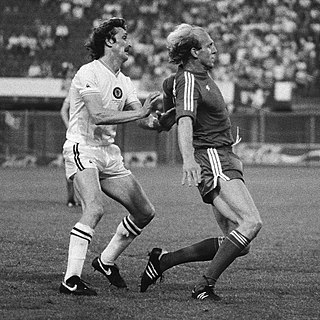Related Research Articles
James Calderwood is a Scottish former football player and manager. Calderwood played for Birmingham City and Dutch clubs Sparta Rotterdam, Willem II Tilburg, Roda JC and Heracles Almelo. After retiring as a player, Calderwood stayed in the Netherlands and became a coach, becoming a manager of Willem II Tilburg and NEC Nijmegen.

Joseph Harry Hampton was an English footballer who was born in Wellington, Shropshire. To this day Hampton remains Aston Villa's all-time leading goalscorer in the League.
Robert Auld was a Scottish football player and manager. He was a member of Celtic's Lisbon Lions, who won the 1967 European Cup Final.
John Reginald Schofield was an English footballer who played as a goalkeeper in the Football League for Birmingham City and Wrexham.

Desmond George Bremner is a Scottish former professional football midfielder. He made more than 600 league appearances for clubs in both Scotland and England, was a member of Aston Villa's European Cup-winning team of 1982, and was capped for the Scotland national team.
Stanley Lynn was an English professional association footballer who played as a right back. He made nearly 450 appearances in the Football League for Accrington Stanley, Aston Villa and Birmingham City. Nicknamed "Stan the Wham", he was renowned for his powerful right-footed shots which came from his "Booming Boots".
Roger Jones is an English former footballer, who played as a goalkeeper who played for Bournemouth & Boscombe Athletic, Blackburn Rovers, Newcastle United, Stoke City, Derby County, Birmingham City and York City.
Alexander Harley was a Scottish professional footballer who played for Third Lanark, Manchester City, Birmingham City, Dundee, Portadown and Cape Town City as a striker.
John Crosbie was a Scottish professional footballer who played as an inside forward in the Scottish Football League for Ayr United and made more than 400 appearances in the Football League for Birmingham. He was capped twice for the Scotland national football team.
Malcolm Beard is an English former professional footballer born in Cannock, Staffordshire, who made more than 350 appearances in the Football League playing as a wing half.
David Barry Latchford is an English former footballer who made 208 appearances in the Football League and 8 in the Scottish League playing as a goalkeeper. He is the older brother of former England international striker Bob Latchford and Celtic goalkeeper Peter Latchford.
Alan James Campbell is a Scottish former professional footballer who played as a central midfielder. He made 571 appearances in the English Football League for Charlton Athletic, Birmingham City, Cardiff City and Carlisle United, including over 100 in the First Division for Birmingham City. He was capped for Scotland at youth and under-23 level. He went on to play and manage in non-League football around the Birmingham area.
John Cameron Fraser is a Scottish former professional footballer who played as a full back. He played 80 games for Dunfermline Athletic in the Scottish Football League and a further 72 for Aston Villa and Birmingham City in the English Football League.
Charles Stanley Duncan was a Scottish professional footballer who scored 88 goal from 266 appearances in the Scottish League and 6 goals from 22 appearances in the English Football League. He began his senior career with Dunfermline Athletic, played for English club Birmingham ither side of the First World War, and returned to Scotland where he represented Rangers, Third Lanark, Clyde, Dundee and Arbroath. He was capped once for the Scottish League representative team. He played as a centre forward.
Lee Robert Jenkins is an English former footballer who played in the Football League for Aston Villa, Port Vale and Birmingham City, and also played in Finland for RoPS and FinnPa.
Peter Gibson Neil was a Scottish footballer who played in the English Football League for Birmingham. He played mainly as an outside right.
Sidney Webb was an English professional footballer who played in the Football League for Birmingham. He played as an inside forward.
James Arthur Murray was a Scottish professional footballer who played in the Football League for Aston Villa and Small Heath. He played as a right-sided forward. He represented the Scottish Junior international team.
William Sanderson Hume was a Scottish professional footballer who played in the Scottish Football League for Dunfermline Athletic, St Mirren and Berwick Rangers, in the Football League, for Birmingham City, and in the Irish Football League and the Inter-Cities Fairs Cup for Glentoran. He played as a wing half or inside forward.
Richard "Ricky" Sharp was a Scottish professional footballer who is best known for his time with Dunfermline Athletic and Kilmarnock.
References
- 1 2 3 "Jim Herriot". Barry Hugman's Footballers. Retrieved 16 May 2017.
- 1 2 3 "Jim Herriot". Hibernian Historical Trust. Retrieved 20 April 2018.
- ↑ More Douglas Players | Jim Herriot, A History of Football in Douglasdale, 12 July 2009
- 1 2 3 "Jim Herriot". Dunfermline Athletic F.C. Archived from the original on 1 March 2008.
- 1 2 Matthews, Tony (1995). Birmingham City: A Complete Record. Derby: Breedon Books. p. 97. ISBN 978-1-85983-010-9.
- ↑ "Determination wins out". Glasgow Herald. 26 April 1965. p. 6.
- ↑ Matthews, Tony (1995). Birmingham City: A Complete Record. Derby: Breedon Books. pp. 201–05. ISBN 978-1-85983-010-9.
- ↑ "James Herriot". Scottish Football Association. Retrieved 20 April 2018.
- ↑ "Herriot, James (Jim)". Aston Villa Player Database. Jörn Mårtensson. Retrieved 20 April 2018.
- ↑ Hosie, Rab. "Appearance records: H". Scottish Football Historical Archive. Archived from the original (DOC) on 27 November 2016.
- ↑ Lewis, Stephen (2 February 2013). "World of James Herriot in Thirsk re-opens with new collection". The Press. York. Retrieved 20 April 2018.
- ↑ "James Herriot International Appearances". eu-football.info. Retrieved 29 April 2023.